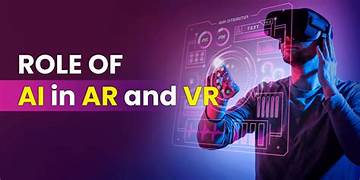The Role of AI in Enhancing Virtual Reality Training Programs
Introduction
Training and education are undergoing a radical transformation with the rise of Virtual Reality (VR) and Artificial Intelligence (AI). These two technologies, when combined, create immersive, interactive, and intelligent training programs that can offer vast improvements over traditional methods. VR allows learners to experience realistic simulations of complex environments, while AI adds a layer of adaptability, personalization, and efficiency. Together, they can create tailored, scalable, and data-driven training solutions for industries ranging from healthcare to military, manufacturing, and corporate environments. This article explores the role of AI in enhancing virtual reality training programs, highlighting how AI can make VR-based learning more effective, efficient, and accessible.
1. Understanding Virtual Reality (VR) Training
Before delving into the specifics of AI’s role in VR, it’s important to understand the fundamental concept of VR training. Virtual reality involves the use of immersive, computer-generated simulations where users interact with a three-dimensional environment. Unlike traditional training methods, which often rely on static materials like textbooks or videos, VR offers hands-on experience, making learning more engaging and memorable.
VR training programs are used in a variety of fields, from medical simulations where trainees practice surgeries or emergency responses, to flight simulators for pilots, and safety drills for workers in hazardous industries. The immersive nature of VR helps bridge the gap between theory and practice, providing learners with experiences they otherwise might not have access to.
However, VR training on its own, while effective, has limitations. It can lack adaptability, personalization, and real-time responsiveness to the individual learner’s needs. This is where AI steps in to elevate VR experiences.
2. Personalization and Adaptive Learning
AI’s biggest contribution to VR training is its ability to personalize the learning experience. One-size-fits-all training models are often ineffective, as they don’t take into account the unique strengths, weaknesses, and learning paces of individual users. AI, particularly through machine learning, can create adaptive training systems that respond to each learner’s actions in real-time.
2.1. Tailoring Learning Paths
AI can track a learner’s progress and identify areas where they are excelling or struggling. Based on this real-time data, the system can adjust the complexity of the virtual environment or the tasks at hand, ensuring that learners are neither overwhelmed nor under-challenged. For example, in a VR-based medical training program, AI could detect whether a trainee is performing a procedure correctly and adjust the difficulty of the task accordingly—perhaps by introducing more complex scenarios or providing additional guidance if the learner is struggling.
This level of personalization enhances the efficiency of training, allowing learners to progress at their own pace and focus on areas where they need improvement. It ensures that every learner gets the right level of challenge, which boosts confidence and promotes better retention of skills.
2.2. Real-Time Feedback
AI also enables real-time feedback during VR training. Traditional training methods often rely on delayed feedback, which can hinder the learning process. For instance, if a trainee is performing a task incorrectly, they might not receive feedback until after the training session, missing out on the opportunity to immediately correct their mistakes.
With AI integration, VR systems can analyze the trainee’s actions in real-time and provide instant feedback. In a VR-based driving simulation, for example, AI can assess the driver’s performance, highlighting mistakes like improper lane changes or missed turns, and provide immediate corrective suggestions. This kind of real-time interaction makes the learning process more dynamic and responsive.
3. Creating More Immersive and Interactive Experiences
The power of VR lies in its ability to simulate real-world environments. However, VR experiences can be limited in terms of interactivity and adaptability. AI addresses this challenge by enabling more dynamic interactions within virtual environments, making the experience feel even more realistic and engaging.
3.1. AI-Driven NPCs (Non-Player Characters)
In many VR training programs, the virtual environment is populated with NPCs that simulate human behavior. These characters are often pre-programmed with a set of behaviors and responses. While this can provide a basic level of interactivity, it lacks the ability to respond in real-time to a learner’s actions.
AI allows NPCs to become much more intelligent and dynamic. Using machine learning, AI-driven NPCs can adapt their behavior based on the actions of the learner, creating a more authentic and engaging experience. For example, in a VR-based customer service training program, AI-powered NPCs can react to different customer behaviors and adjust their responses accordingly, providing a more realistic simulation of real-world interactions.
These intelligent NPCs can also serve as virtual mentors or training assistants, guiding users through different tasks, providing tips, and responding to questions in a natural, conversational manner. This not only improves the realism of the training experience but also adds a layer of human-like interaction that helps learners feel more comfortable and supported.
3.2. Realistic Scenarios and Dynamic Environments
AI can also be used to generate more complex and dynamic scenarios within a VR environment. By analyzing data from a variety of sources, AI can introduce random events, challenges, or changing conditions to simulate real-life uncertainty and unpredictability. In industries like healthcare, military, or aviation, this ability to simulate unpredictable situations is vital for preparing learners to respond effectively in real-world situations.
For instance, a VR training program for emergency responders could use AI to simulate a variety of crisis situations—such as natural disasters, accidents, or security threats—with different outcomes each time, based on the actions of the trainee. AI could also adapt the environment based on the learner’s performance, increasing or decreasing the complexity of the scenario to ensure continuous improvement.
4. Improving Data Analysis and Reporting
AI excels at processing vast amounts of data, which makes it particularly useful for analyzing the performance of learners in VR training programs. AI algorithms can track numerous metrics such as response time, decision-making, accuracy, and efficiency during training exercises. This data can be used to generate detailed reports that offer insights into the learner’s strengths and areas for improvement.
4.1. Performance Analytics
For instructors or trainers, AI-powered analytics can provide in-depth insights into how well trainees are performing across different scenarios. These insights can help trainers make informed decisions about how to adapt training programs, such as focusing more on areas where learners consistently struggle or identifying trends that indicate a need for more comprehensive support.
For example, in a VR-based industrial safety training program, AI might detect that multiple learners consistently fail to react to specific safety hazards in a timely manner. With this data, trainers can adjust the curriculum to focus more on those specific scenarios, ultimately improving the program’s overall effectiveness.
4.2. Identifying Trends and Improving Training Effectiveness
AI’s ability to process large amounts of data also enables organizations to track long-term trends in training effectiveness. By aggregating data from multiple training sessions, AI can identify patterns in the learning process, helping organizations refine training methods and make them more efficient.
For example, if data from multiple trainees reveals that a particular simulation is consistently resulting in poor performance, AI can highlight the issue for further analysis. It could indicate that the simulation itself needs to be redesigned, or that specific elements within the simulation are not adequately challenging or informative.
5. Overcoming Challenges and Ethical Considerations
While AI’s integration with VR training has vast potential, it also presents some challenges and ethical considerations. One of the primary concerns is the accuracy and reliability of AI-driven decision-making. AI systems rely on data, and if the data used to train the AI is biased or incomplete, it could lead to inaccurate conclusions or feedback. Ensuring that AI systems are trained on diverse and representative data sets is crucial for maintaining fairness and effectiveness in VR training programs.
Moreover, there are privacy and data security issues to consider, especially in training environments that involve sensitive information, such as medical or military training. Ensuring that AI-powered VR systems adhere to strict data privacy regulations is essential to maintaining trust and security.
6. The Future of AI in VR Training
Looking ahead, the role of AI in VR training will continue to evolve. As AI systems become more sophisticated, they will offer even greater levels of personalization, adaptability, and interactivity. The ability of AI to simulate complex, unpredictable scenarios and provide real-time feedback will make VR training programs even more effective and immersive.
In the future, we may also see greater integration between AI-driven VR training systems and other emerging technologies, such as augmented reality (AR), wearables, and brain-computer interfaces (BCIs), creating even more immersive and integrated training environments.
Conclusion
AI’s role in enhancing VR training programs is transformative, making training more personalized, interactive, and effective. By enabling adaptive learning, real-time feedback, dynamic scenarios, and in-depth performance analytics, AI is helping organizations create training programs that are not only more engaging but also more efficient and impactful. As both AI and VR technologies continue to evolve, their combined potential to revolutionize training across various industries will only grow, offering more innovative, accessible, and scalable solutions for learners and organizations alike.


